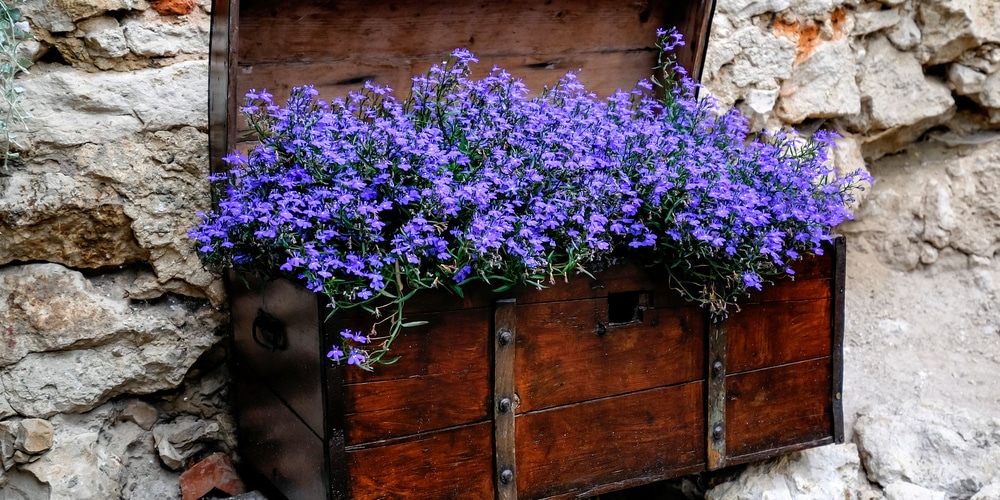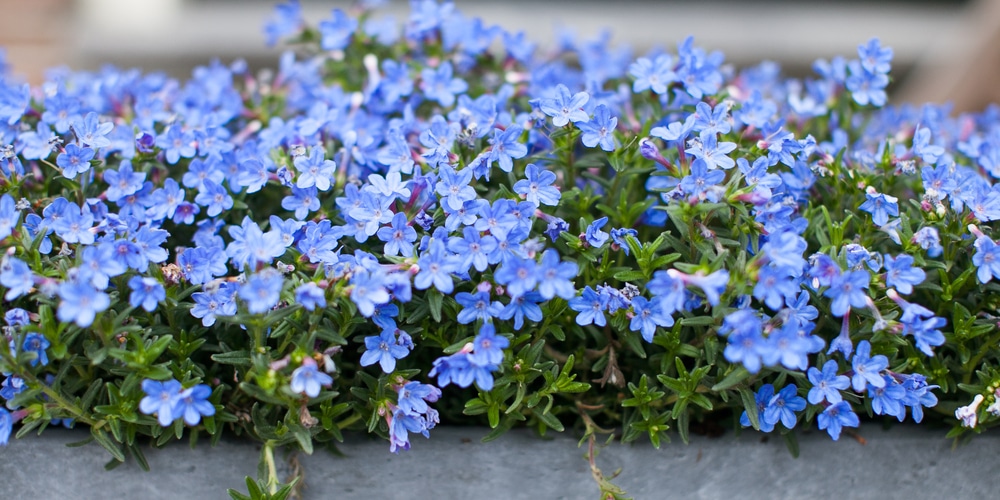Trailing Lobelia Sapphire is a great plant to grow in hanging baskets and cascading from balconies. It can also serve to create attractive borders around your property. Indeed, these plants have neat trailing habits that make them spill over their containers, creating a stunning effect, especially during the blooming season.
While there are many varieties of Lobelia, you can distinguish the Sapphire species for its intense purple-blue flowers that contrast with the deep green foliage.
The plant makes for a perfect backdrop if you decide to plant it as a cover bed. It grows compact and stays low to the ground, making it an ideal option to add texture to your garden. Also, under optimal conditions, this plant produces tons of flowers.
While other trailing Lobelia has purple to blue blooms, the Sapphire variety presents a white center that makes it even more unique-looking. Because of the plant’s fast growth, you can expect it to fill your yard with plenty of colors. The results will be stunning.
While Lobelias are generally easy to care for, you should be familiar with their basic requirements to ensure they will thrive in your garden. Keep reading this essential guide to learning everything you should know about this plant. Put our tips into practice to recreate the optimal conditions for Trailing Lobelia Sapphire to thrive.
Trailing Lobelia Sapphire Characteristics
Like most Lobelia plants, the Sapphire variety blooms between early spring and fall. Compared to other trailing species, this type of Lobelia blooms about four weeks earlier. If your objective is to make your garden more colorful for the most time, consider getting Lobelia Sapphire: you won’t get disappointed. Also, you can combine it with late-bloomers to further increase the blooming season. Pick species that contrast nicely with its blue colors for best results.
But how can you recognize this plant?
For starters, its foliage is dense and dark green. The leaves of this plant are small and delicate-looking, creating an attractive backdrop. The plant is relatively easy to grow: once you have it established in your yard, it will reach maturing within one to two years without much help.
The good news is that this species is suitable even for limited spaces: it won’t grow more than 2 feet in height and width. If you don’t know if you got the proper variety, look at your plant’s blooms: if they are deep blue or purple with a white eye in the middle, you have a Sapphire in your garden!
Growing Conditions
This type of Lobelia erinus, like its cousins, doesn’t need much to thrive. It is an annual plant that performs well in hardiness zones between 8 and 11 and prefers soil temperatures around 65F.
Place these plants under full sun or partial shade, depending on how warm summers get in your region. If you live somewhere dry and hot, the partial shade will do. Protect your plants from the harsh sunlight in the afternoon hours to prevent them from drying and wilting. Plus, the blooms’ colors will look brighter under adequate lighting conditions.
These plants can adapt to various soil conditions but perform best in fertile and well-drained grounds. Ensure you add mulch around them to keep them moist even during the hottest months of the year.
You won’t have to fertilize your plants regularly. However, if you prefer voluminous and continuous blooming, you can add a liquid fertilizer once per year during the spring.
Trailing Lobelia Sapphire: The Bottom Line
Regardless of where you decide to place Trailing Lobelia Sapphire in your garden, you will most likely get stunning results. Whether you make it a hedge plant to protect your garden and elegantly add some privacy or place it in hanging baskets around your porch, this plant will improve your property looks.
And the best part is that it is relatively easy to grow: even without your help, this plant will thrive, provided that it receives the amount of light it needs and adequate watering. If you live somewhere where rain doesn’t fall regularly, ensure you keep your plants moist. Plus, if you place your Trailing Lobelia Sapphire in a hanging basket, you must increase the watering frequency.
Besides such details, you won’t have to worry much about growing this plant. Despite its delicate looks, it is a versatile and easily adaptable plant that can serve various purposes.

